
James Henry Flatley III (born January 9, 1934, in San Diego), [1] is a retired rear admiral in the United States Navy. A naval aviator, fighter pilot, and test pilot, he is the son of Vice Admiral James H. Flatley. [2]

James Henry Flatley III (born January 9, 1934, in San Diego), [1] is a retired rear admiral in the United States Navy. A naval aviator, fighter pilot, and test pilot, he is the son of Vice Admiral James H. Flatley. [2]
Flatley is a 1956 graduate of the United States Naval Academy. [3] He later received an MBA from Auburn University. [4]
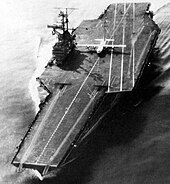
While a lieutenant at the Naval Air Test Center at NAS Patuxent River, Maryland, Flatley and his fellow crew members, LCDR Walter W. "Smokey" Stovall and Aviation Machinist's Mate (Jet). V 1st Class Ed Brennan, made history when they completed 21 full-stop landings and takeoffs in a Lockheed C-130 Hercules aboard the aircraft carrier USS Forrestal; it was the largest plane, with the heaviest load, ever to successfully land on a carrier. Flatley later commanded the aircraft carrier USS Saratoga. While serving as the commanding officer of the USS Saratoga in 1980, he completed his 1,500th arrested landing in an F-4 Phantom. He retired in 1987. [3]
Awards he received during his career include the Silver Star, the Distinguished Flying Cross and the Air Medal. [4] He has also been inducted into the U.S. Naval Aviation Carrier Hall of Fame and the South Carolina Aviation Hall of Fame. [5]
In a June 2017 tribute article, Flatley discussed his history in the field of aviation and reflected on his and the Flatley family's legacy, estimating that the "extended Flatley family has accumulated more than 6,100 incident/accident-free arrested carrier landings." [6]
Rear Admiral Flatley is married to Nancy Monica Christie of Norfolk, Virginia. They have six children. Their two oldest sons, James H. Flatley IV and Joseph F. Flatley are Navy fighter pilots and their youngest daughter Kara is a lieutenant in the Supply Corps and is married to Richard Brophy, a Navy fighter pilot. Her sister, Mary, is married to Rex Kiteley, a Navy flight surgeon. RADM Flatley's father was James H. Flatley, the USS Yorktown 's first air group commander and World War II fighter ace and the Pacific theater namesake for carrier aviations Safety Award – The Flatley Award. He now resides in Charleston, South Carolina with his wife.

USS Wasp (CV-7) was a United States Navy aircraft carrier commissioned in 1940 and lost in action in 1942. She was the eighth ship named USS Wasp, and the sole ship of a class built to use up the remaining tonnage allowed to the U.S. for aircraft carriers under the treaties of the time. As a reduced-size version of the Yorktown-class aircraft carrier hull, Wasp was more vulnerable than other United States aircraft carriers available at the opening of hostilities. Wasp was initially employed in the Atlantic campaign, where Axis naval forces were perceived as less capable of inflicting decisive damage. After supporting the occupation of Iceland in 1941, Wasp joined the British Home Fleet in April 1942 and twice ferried British fighter aircraft to Malta.

USS Saratoga (CV/CVA/CVB-60), was the second of four Forrestal-class supercarriers built for the United States Navy in the 1950s. Saratoga was the sixth U.S. Navy ship, and the second aircraft carrier, to be named for the Battles of Saratoga in the American Revolutionary War.

John Smith Thach was a World War II Naval Aviator, air combat tactician, and United States Navy admiral. Thach developed the Thach Weave, a combat flight formation which could counter enemy fighters of superior performance, and later the big blue blanket, an aerial defense against kamikaze attacks.

Marc Andrew "Pete" Mitscher was a pioneer in naval aviation who became an admiral in the United States Navy, and served as commander of the Fast Carrier Task Force in the Pacific during World War II.

John Henry Towers CBE was a highly decorated United States Navy four-star admiral and pioneer naval aviator. He made important contributions to the technical and organizational development of naval aviation from its beginnings, eventually serving as Chief of the Bureau of Aeronautics (1939–1942). He commanded carrier task forces during World War II, and retired in December 1947. He and Marc Mitscher were the only early Naval Aviation pioneers to survive the hazards of early flight to remain with naval aviation throughout their careers. Towers spent his last years supporting aeronautical research and advising the aviation industry.
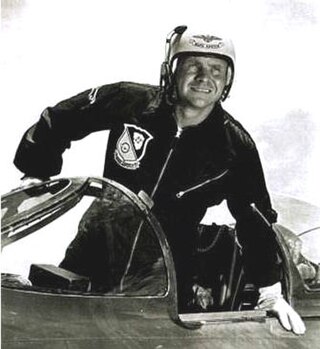
Captain Roy Marlin "Butch" Voris was an aviator in the United States Navy, a World War II flying ace, and the founder of the Navy's flight demonstration squadron, the Blue Angels. During his 22-year naval career Voris flew everything from biplanes to jets, and afterward was instrumental in the development of the Navy's F-14 Tomcat strike fighter and NASA's Apollo Lunar Module (LM), both produced by the Grumman Aerospace Corporation.

Miles Rutherford Browning was an officer in the United States Navy in the Atlantic during World War I and in the Pacific during World War II. An early test pilot in the development of carrier-based Navy aircraft and a pioneer in the development of aircraft carrier combat operations concepts, he is noted for his aggressive aerial warfare tactics as a Navy captain on the Admiral's staff aboard USS Enterprise and at Nouméa during World War II. His citation for the Distinguished Service Medal states: "His judicious planning and brilliant execution was largely responsible for the rout of the enemy Japanese fleet in the Battle of Midway." Naval historian Craig Symonds disagrees, however, writing that "the citation claim that Browning was 'largely responsible' for the American victory at Midway, an assertion that some historians have taken seriously. .. is manifestly untrue."
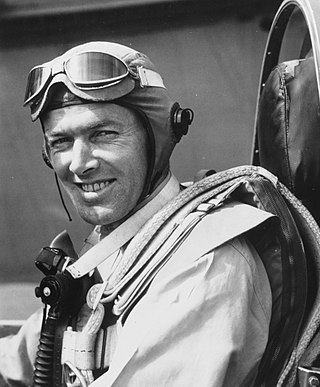
Vice Admiral James Henry Flatley Jr. was a World War II naval aviator and tactician for the United States Navy (USN). He became a fighter ace credited with shooting down six enemy aircraft in aerial combat.

John Sidney McCain Sr. was a United States Navy admiral and the patriarch of the McCain military family. McCain held several commands during the Pacific War of World War II and was a pioneer of aircraft carrier operations. He and his son, John S. McCain Jr., were the first father-and-son pair to achieve four-star admiral rank in the U.S. Navy.
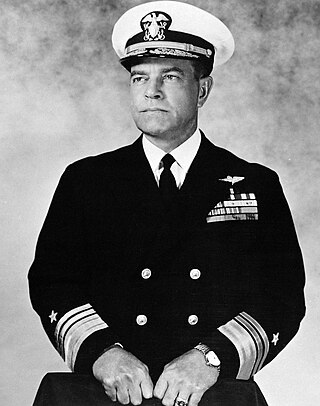
Patrick Nieson Lynch Bellinger CBE was a highly decorated officer in the United States Navy with the rank of Vice Admiral. A Naval aviator and a naval aviation pioneer, he participated in the Trans-Atlantic flight from Newfoundland to Azores in May 1919 and was decorated with Navy Cross, the United States military's second-highest decoration awarded for valor.

Thomas McClelland is a decorated U.S. Navy veteran who served in the Vietnam War and Operation Desert Storm.
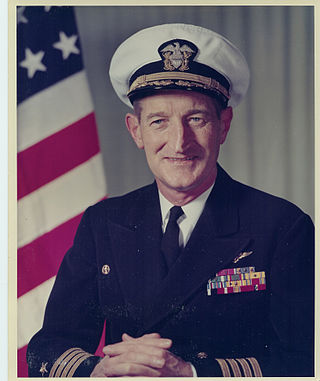
Frederick T. Moore Jr. was a United States Navy captain. During World War II, he was executive officer of Fighter Squadron 1 operating off the carrier USS Yorktown (CV-10) and commanding officer of the Air Group 35 aboard the aircraft carrier USS Chenango in the Pacific. During the Korean War, he was the commanding officer of naval air training at NAS Pensacola and the air officer on USS Coral Sea. His first sea command was aboard USS Suribachi. In 1962–1963, Moore was the eighth commanding officer of USS Saratoga. Late in his career during the Vietnam War, he was Chief of Staff of the Naval Air Training Command at Naval Air Station Pensacola from October 1965 to July 1969.
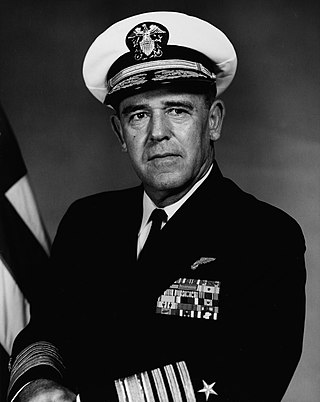
John Joseph Hyland Jr was an admiral in the United States Navy who commanded the U.S. Pacific Fleet from 1967 to 1970. A naval aviator, he was a champion of the aircraft carrier.

Rear Admiral Edward Lewis Feightner was a United States Navy officer who fought in a number of significant battles in the World War II Pacific Theater of Operations. During two combat tours, he shot down nine enemy aircraft to become a flying ace.

Brian Eugene "Lex" Luther is a rear admiral in the United States Navy.

Paul Thomas Gillcrist was a rear admiral in the United States Navy. After retirement from the Navy, he wrote non-fiction and fiction books and was a consultant for television.
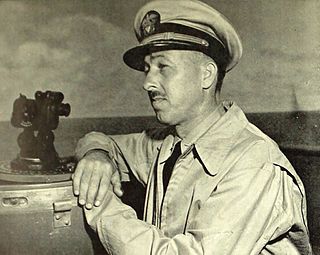
Frank Peak Akers was an American naval rear admiral who was the first aviator to make an instrument landing aboard an aircraft carrier.

Stanley Winfield "Swede" Vejtasa was a United States Navy career officer and World War II flying ace. During the Battle of the Santa Cruz Islands, he was credited with downing seven Japanese aircraft in one mission, becoming an "ace in a day".

Walter Jackson Davis Jr. is a retired vice admiral in the United States Navy who served as Director of Space and Electronic Warfare in the Office of the Chief of Naval Operations (CNO). From 28 February 1996 until his retirement on 1 January 1997, he was U.S. naval aviation's Gray Eagle. Davis was the second African American to become the most senior naval aviator on active duty.
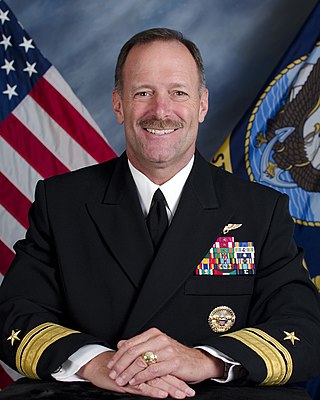
Michael Charles Manazir, also known as Rear Admiral Mike Manazir, is a retired United States Navy two-star admiral who transitioned to civilian life from duty as the deputy chief of naval operations for warfare systems on July 7, 2017.
{{cite web}}: CS1 maint: archived copy as title (link) ![]() Media related to James H. Flatley III at Wikimedia Commons
Media related to James H. Flatley III at Wikimedia Commons